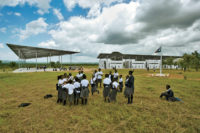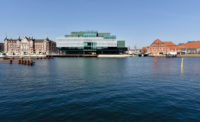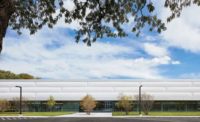Kalvebod Fælled School by Lundgaard & Tranberg Arkitekter
Copenhagen

Adjacent to 3XN’s Royal Arena, the Kalvebod Fælled School is another circular landmark bordering a nature preserve.
Photo © Anders Sune Berg

Skylights located throughout the concrete post-and-beam structure bathe the interior in sunlight.
Photo © Torben Eskerod

The glazed gymnasium has a steel structure, and its interior can be viewed from most areas.
Photo © Torben Eskerod

The glazed gymnasium has a steel structure, and its interior can be viewed from most areas.
Photo © Anders Sune Berg

The auditorium, below the gym at the center of the first level, features a ground-concrete floor and built-in seating.
Photo © Anders Sune Berg

Students dine in an informal cafeteria along the perimeter.
Photo © Torben Eskerod

The interstitial space is bathed in sunlight.
Photo © Torben Eskerod

The surrounding marshlands offer striking views from within the classrooms.
Photo © Dennis Lehmann

The surrounding marshlands offer striking views from within the classrooms.
Photo © Anders Sune Berg

The undulating landscape design encourages movement.
Photo © Dennis Lehmann

Image courtesy Lundgaard & Tranberg Arkitekter

Image courtesy Lundgaard & Tranberg Arkitekter

Image courtesy Lundgaard & Tranberg Arkitekter













Architects & Firms
The landscape of Ørestad, a fairly recent development of office buildings, educational facilities, and housing on the southern outskirts of Copenhagen, next to hauntingly beautiful marshlands, is an odd array of wide-open spaces—often without a soul in sight—lined mainly with competent but sedate contemporary architecture. There are some exceptions, notably BIG’s 8 House, in the form of a cascading figure eight. But more immediately visible from the elevated train and metro lines that swiftly connect this new area to the city center and the airport are a pair of distinctive round buildings. The larger of the two, the Royal Arena (2017), designed by 3XN, has become a popular venue for concerts and sporting events. The smaller one has a program not as obviously associated with its cylindrical form.
Additional Content:
Jump to credits & specifications
Indeed, the Kalvebod Fælled School is unlike most public schools, not just for its shape but for its design in the broadest sense, because it caters to progressive educational and sustainable goals. Its architects, from the Copenhagen-based firm Lundgaard & Tranberg, have embraced building in the round, having completed the 300-foot-diameter Tietgen Dormitory (2006) just over three miles to the north of this school, and the Axel Towers (2017), a cluster of five circular office buildings in the heart of the city. While the dormitory includes an expansive courtyard at its center and, at the towers, elevator cores, Lundgaard & Tranberg did something unique with the school, placing a large gymnasium within its belly, to create a compact and efficient drum of a building with a rich diversity of spaces.
The three-story-high rectangular gymnasium spans levels two through four of the five-story building. Beneath it, on the ground floor, is the gently sloping auditorium, surrounded by irregularly shaped pods containing locker rooms and mechanical equipment and, wrapped along the perimeter, the cafeteria, kitchen, faculty offices, and special areas, including a large music studio. On the upper levels, classrooms, labs, and makerspaces comprise the outer ring of the building. Each upper level also contains a couple of large common areas projecting from the ring, like terraces, where students can hang out or study. Uniting all those rooms is a fullheight interstitial yet grand space, bathed in sun through skylights located between the 64-foot-tall poured-concrete piers that march along the outside of the steel-framed glazed gymnasium, providing visual access across all parts of the building.
If the plan recalls that of a panopticon—that 18th-century experiment for institutional buildings, adopted mainly for prisons as a way to monitor inmates from a single, central point—its intention was the opposite. Rather than a means of surveillance, the design here allows everyone to see everyone, in a friendly way. “I think it gives the children a sense of freedom,” muses Lundgaard & Tranberg founding partner Lene Tranberg about the 800 students, ages 6 to 16, that the school will eventually accommodate.
While the design of the building may seem inwardly focused, with the energy and activity of the gymnasium at its core, the spirit of the school is one that reaches out—quite literally to the soccer field and playground, to which the students escape throughout the day as part of the active curriculum. The community also has regular access to the building after school hours. “There are people in this building until 10 o’clock most nights,” says Anita Lindholm Krak, an architect on the project. The rolling terrain around the school, designed by BOGL landscape architects, encourages movement. Likewise, the 124,000-square-foot building is served only by one key-operated elevator, to ensure that children use the stairs.
When not outdoors, the occupants can’t help but look outside. The school sits at the edge of the Ørestad development, with a nature preserve on the other side. Windmills in the distance are a reminder of the nontraditional forms of energy that are commonly used in Denmark. And the school does its part, operating at nearly zero-energy level. “We thought about installing solar panels,” says Lindholm Krak, “but, rather than incur the additional cost and maintenance, we looked at ways to lower energy consumption.” Extensive daylighting is one way. Also, there is no mechanical air conditioning: the building relies on passive ventilation and night cooling (due to the high concrete mass of the building), and efficient biomass district heating is employed.
Most noticeably, the building’s facade—a mix of solid and perforated raw aluminum panels installed over staggered windows on the upper three levels—reacts to the sun, automatically shifting the position of the perforated panels to avoid heat gain and glare. (Teachers within the classrooms can manually adjust the panels as well.) A 6½- foot overhang protects the ground floor, which features a double-height window wall, from the sun. All windows are triple glazed.
Lundgaard & Tranberg used a very simple palette of pine wood (backed by felt acoustic insulation in certain areas, principally the auditorium), concrete, and glass throughout the building, designing the custom cabinetry, lockers, and nooks, and eliminating surfaces that require painting.
Kalvebod Fælled is the first school Lundgaard & Tranberg has completed, and it shows. The architects managed to avoid the usual tropes commonly associated with school facilities and instead produced an exceptional work of architecture befitting a building for elementary and secondary education—the design for which is often an unheralded task—and fitting the ambitious aspirations of this school in particular. As Lindholm Krak puts it, “Building a school is one of the finer things you can do.”
CreditsArchitect: Lundgaard & Tranberg Arkitekter
Engineering: Dansk Energi Management & Esbensen (technical); Jørgen Nielsen Rådgivende Ingeniører (construction & fire)
Consultants: BOGL (landscape); Gade & Mortensen Akustik (acoustics)
General contractor: MT Højgaard
Size: 124,400 square feet
Cost: $58 million
Completion date: April 2018 |
SpecificationsWindows and doors Wallmakers
Interior wood cladding Tripplex
Acoustic curtains Fischer
Furniture Flötotto (classrooms); Vitra/Artek |




















